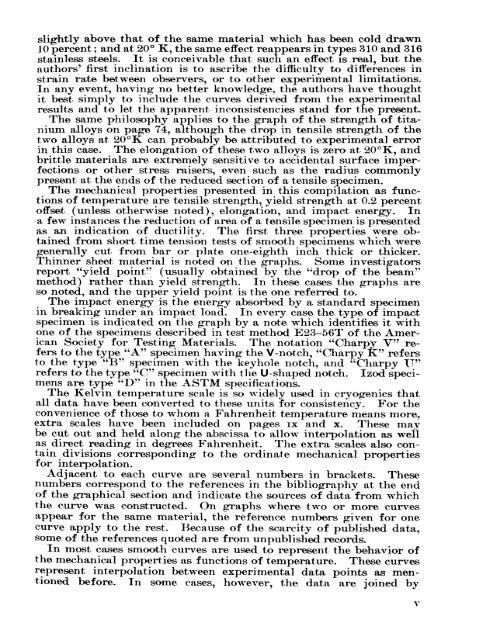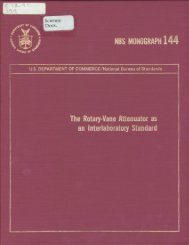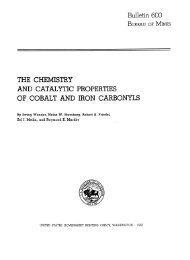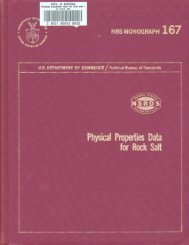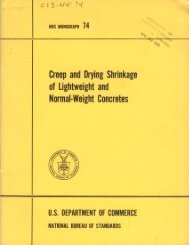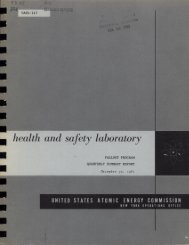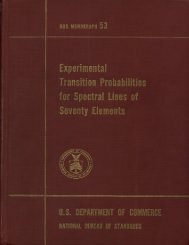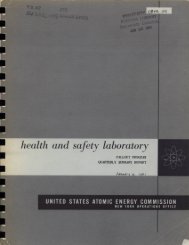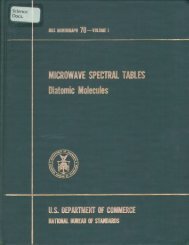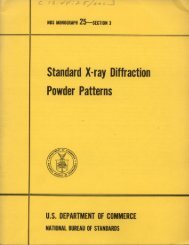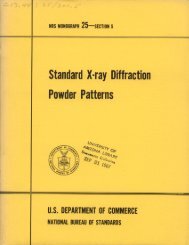impact energy of aisi 3o2 stainless steel - Digital Collections
impact energy of aisi 3o2 stainless steel - Digital Collections
impact energy of aisi 3o2 stainless steel - Digital Collections
Create successful ePaper yourself
Turn your PDF publications into a flip-book with our unique Google optimized e-Paper software.
slightly above that <strong>of</strong> the same material which has been cold drawn<br />
10 percent; and at 20 K, the same effect reappears in types 310 and 316<br />
<strong>stainless</strong> <strong>steel</strong>s. It is conceivable that such an effect is real, but the<br />
authors' first inclination is to ascribe the difficulty to differences in<br />
strain rate between observers, or to other experimental limitations.<br />
In any event, having no better knowledge, the authors have thought<br />
it best simply to include the curves derived from the experimental<br />
results and to let the apparent inconsistencies stand for the present.<br />
The same philosophy applies to the graph <strong>of</strong> the strength <strong>of</strong> tita<br />
nium alloys on page 74, although the drop in tensile strength <strong>of</strong> the<br />
two alloys at 20 K can probably be attributed to experimental error<br />
in this case* The elongation <strong>of</strong> these two alloys is zero at 20 K, and<br />
brittle materials are extremely sensitive to accidental surface imper<br />
fections or other stress raisers, even such as the radius commonly<br />
present at the ends <strong>of</strong> the reduced section <strong>of</strong> a tensile specimen.<br />
The mechanical properties presented in this compilation as func<br />
tions <strong>of</strong> temperature are tensile strength, yield strength at 0.2 percent<br />
<strong>of</strong>fset (unless otherwise noted), elongation, and <strong>impact</strong> <strong>energy</strong>. In<br />
a few instances the reduction <strong>of</strong> area <strong>of</strong> a tensile specimen is presented<br />
as an indication <strong>of</strong> ductility. The first three properties were ob<br />
tained from short time tension tests <strong>of</strong> smooth specimens which were<br />
generally cut from bar or plate one-eighth inch thick or thicker.<br />
Thinner sheet material is noted on the graphs. Some investigators<br />
report "yield point" (usually obtained by the "drop <strong>of</strong> the beam' 7<br />
method) rather than yield strength. In these cases the graphs are<br />
so noted, and the upper yield point is the one referred to.<br />
The <strong>impact</strong> <strong>energy</strong> is the <strong>energy</strong> absorbed by a standard specimen<br />
in breaking under an <strong>impact</strong> load. In every case the type <strong>of</strong> <strong>impact</strong><br />
specimen is indicated on the graph by a note which identifies it with<br />
one <strong>of</strong> the specimens described in test method E23 56T <strong>of</strong> the Amer<br />
ican Society for Testing Materials. The notation "Charpy V" re<br />
fers to the type "A" specimen having the V-notch, "Charpy K" refers<br />
to the type "B" specimen with the keyhole notch, and "Charpy U"<br />
refers to the type "C" specimen with the U-shaped notch. Izod speci<br />
mens are type "D" in the ASTM specifications.<br />
The Kelvin temperature scale is so widely used in cryogenics that<br />
all data have been converted to these units for consistency. For the<br />
convenience <strong>of</strong> those to whom a Fahrenheit temperature means more,<br />
extra scales have been included on pages ix and x. These may<br />
be cut out and held along the abscissa to allow interpolation as well<br />
as direct reading in degrees Fahrenheit. The extra scales also con<br />
tain divisions corresponding to the ordinate mechanical properties<br />
for interpolation.<br />
Adjacent to each curve are several numbers in brackets. These<br />
numbers correspond to the references in the bibliography at the end<br />
<strong>of</strong> the graphical section and indicate the sources <strong>of</strong> data from which<br />
the curve was constructed. On graphs where two or more curves<br />
appear for the same material, the reference numbers given for one<br />
curve apply to the rest. Because <strong>of</strong> the scarcity <strong>of</strong> published data,<br />
some <strong>of</strong> the references quoted are from unpublished records.<br />
In most cases smooth curves are used to represent the behavior <strong>of</strong><br />
the mechanical properties as functions <strong>of</strong> temperature. These curves<br />
represent interpolation between experimental data points as men<br />
tioned before. In some cases, however, the data are joined by<br />
v


